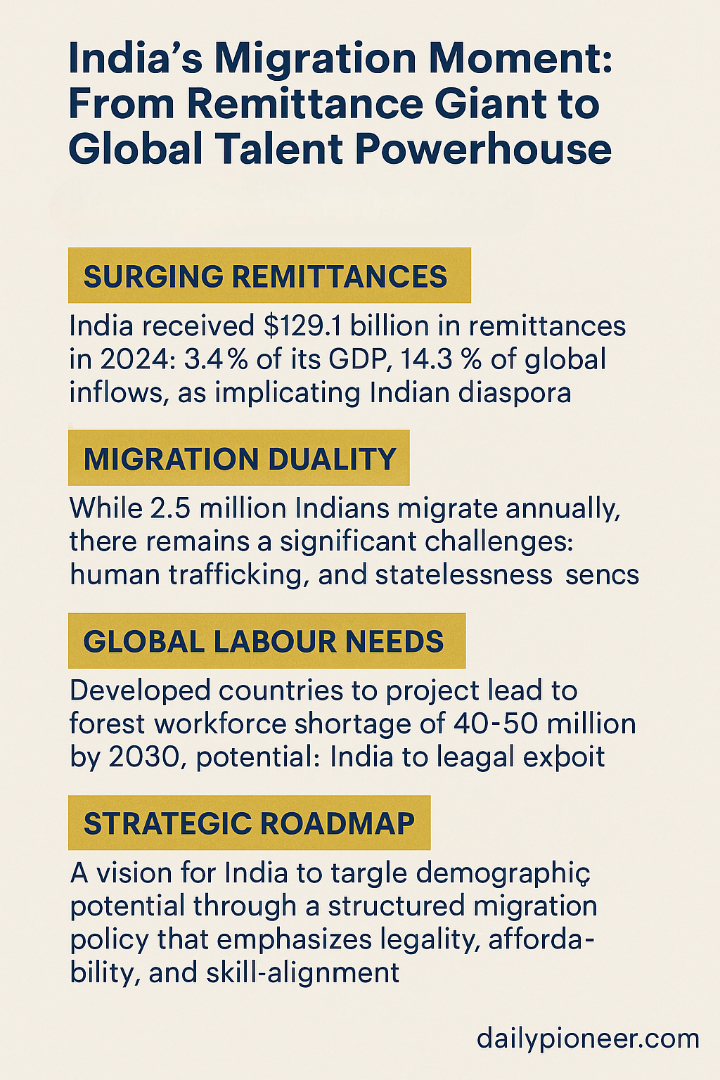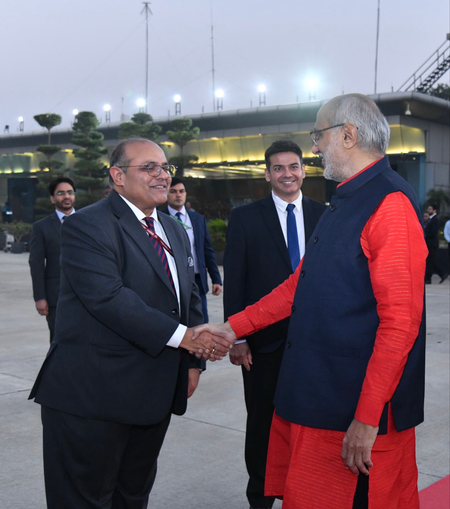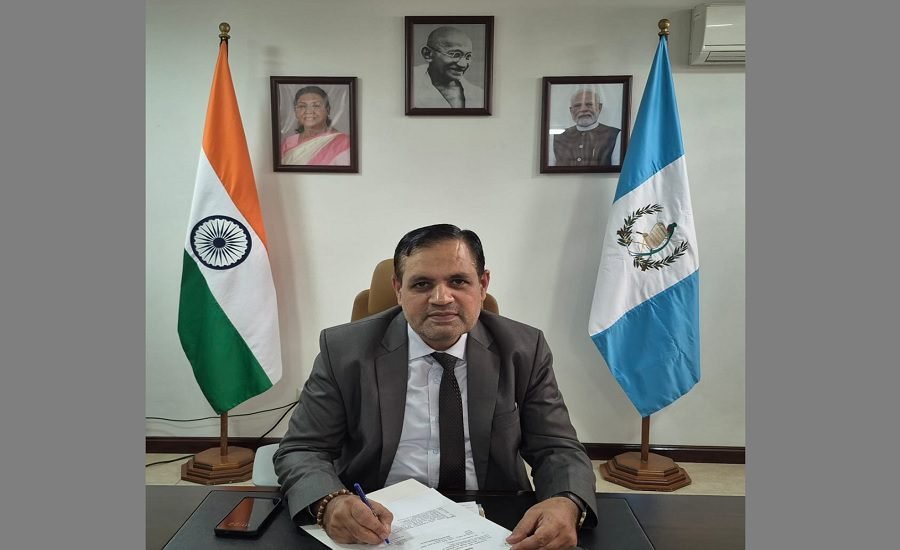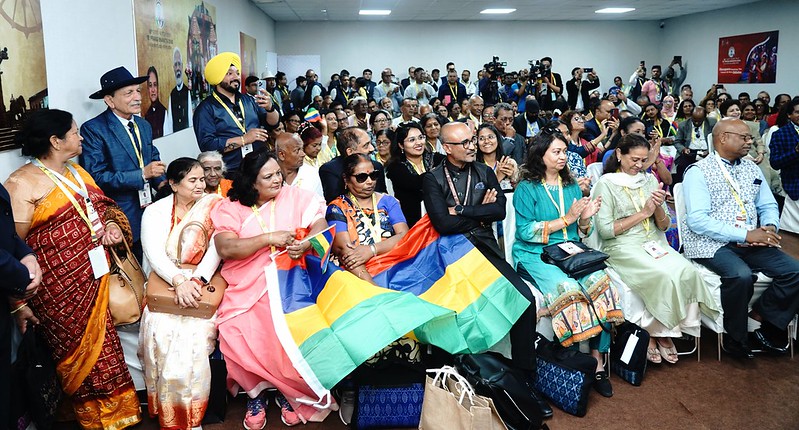From the smallest village to global capitals, Indian migrants are already shaping the world. It’s time India shapes the future of migration—legally, compassionately, and purposefully
India, with its vast and youthful population, stands at the cusp of a transformative opportunity. As developed nations grapple with growing labour shortages, India’s demographic dividend could become a powerful global asset—if channelled through a structured, ethical, and strategic talent export framework, wrote A.S. Mittal in dailypioneer.com.
- S. Mittal serves as the Vice-Chairman of the Punjab Economic Policy and Planning Board, holding a Cabinet Minister rank, and is also the Chairman of the Northern Region Development Council at ASSOCHAM.
The article cited a report from the Reserve Bank of India, which said India received a record-breaking $129.1 billion in remittances in 2024, representing 3.4% of the national GDP and 14.3% of global inflows.
This surpasses nearly 30% of India’s merchandise exports and highlights the critical role of the Indian diaspora—over 35 million strong—in bolstering the country’s economy and acting as a buffer during global economic shocks.

Punjab, often spotlighted for irregular migration issues, received ₹32,535 crore in remittances in 2024—amounting to more than half of its merchandise exports. Similarly, states like Kerala have long relied on remittances to fund household spending, real estate, education, and local infrastructure. Indeed, in many developing countries, remittances now surpass Foreign Direct Investment, and India is no exception.
However, India’s migration landscape is marked by stark contrasts. While 2.5 million Indians legally migrate each year, a significant portion continues to pursue irregular and often dangerous pathways due to limited legal options and awareness. States such as Uttar Pradesh, Bihar, Andhra Pradesh, and Kerala witness both economic gains and social costs from migration—ranging from human trafficking to statelessness.
The Global Opportunity
As labour gaps widen across OECD nations like the U.S., Germany, Australia, Japan, and the U.K.—with projected workforce shortages reaching 40–50 million by 2030 and 160 million by 2040—India is uniquely positioned to fill this vacuum. With over 65% of its population under 35, India can emerge as a global hub for skilled human capital.
But this potential can only be realized through a deliberate policy shift. The proposed Overseas Mobility (Facilitation and Welfare) Bill, 2024, aims to modernize the outdated Emigration Act of 1983, building a transparent and welfare-centric migration system. Yet, legislation alone will not suffice. A mission-mode strategy involving central and state governments, skilling agencies, and the private sector is vital.
A Seven-Pronged Roadmap
To unleash this potential, India must consider adopting a comprehensive “Talent Export Policy” akin to the “Invest India” initiative. Here are key pillars for such a framework:
National Overseas Employment Authority
A centralized body under the Ministry of External Affairs should coordinate with state governments to identify global demand, facilitate skill-matching, and negotiate migration corridors. District-level Migration Resource Centres and well-equipped embassy helpdesks abroad are essential.
Global Skill Integration
Skilling programmes must align with international job standards, including language proficiency and cross-cultural communication. Collaboration between NSDC and partner nations can ensure mutual recognition of qualifications.
Affordable Migration Pathways
Legal migration to countries like those in Europe can cost up to ₹10 lakh. To deter illegal migration, India must offer low-interest loans, training subsidies, and employer-sponsored models similar to the Philippines’ ESA-Pay system.
Strengthened Migrant Welfare Abroad
Indian missions should enforce ILO-compliant standards, and expand access to legal aid, health insurance, and cultural orientation. Scaling up the Indian Community Welfare Fund (ICWF) can offer real-time support to migrants.
Expanded Migration Agreements
India should increase its portfolio of Bilateral Labour Mobility Agreements (BLMAs) with comprehensive provisions for wages, insurance, housing, and grievance redress mechanisms—mirroring successful pacts with Japan, UAE, and Germany.
National Mobility Industry Council
A council comprising ethical recruitment firms, skilling institutes, employers, and regulators can standardize practices, reduce exploitation, and ensure accountability.
Support for Returning Migrants
Returnees bring valuable global exposure and savings. Structured reintegration programs with access to reskilling, credit, and entrepreneurship support can help them become job creators at home.
Migration as a Strategic Asset
India’s migration story is no longer just about economic survival—it is about strategic influence. A well-supported diaspora can shape foreign policy, promote trade, and enhance cultural diplomacy. Countries like the Philippines, Mexico, and Vietnam already recognize the power of structured migration strategies.
If India acts now—investing in legal, skill-aligned, and affordable migration—it can elevate its status from being the world’s largest remittance recipient to becoming a respected global exporter of talent. Migration, when managed ethically and strategically, can become one of India’s greatest strengths.











